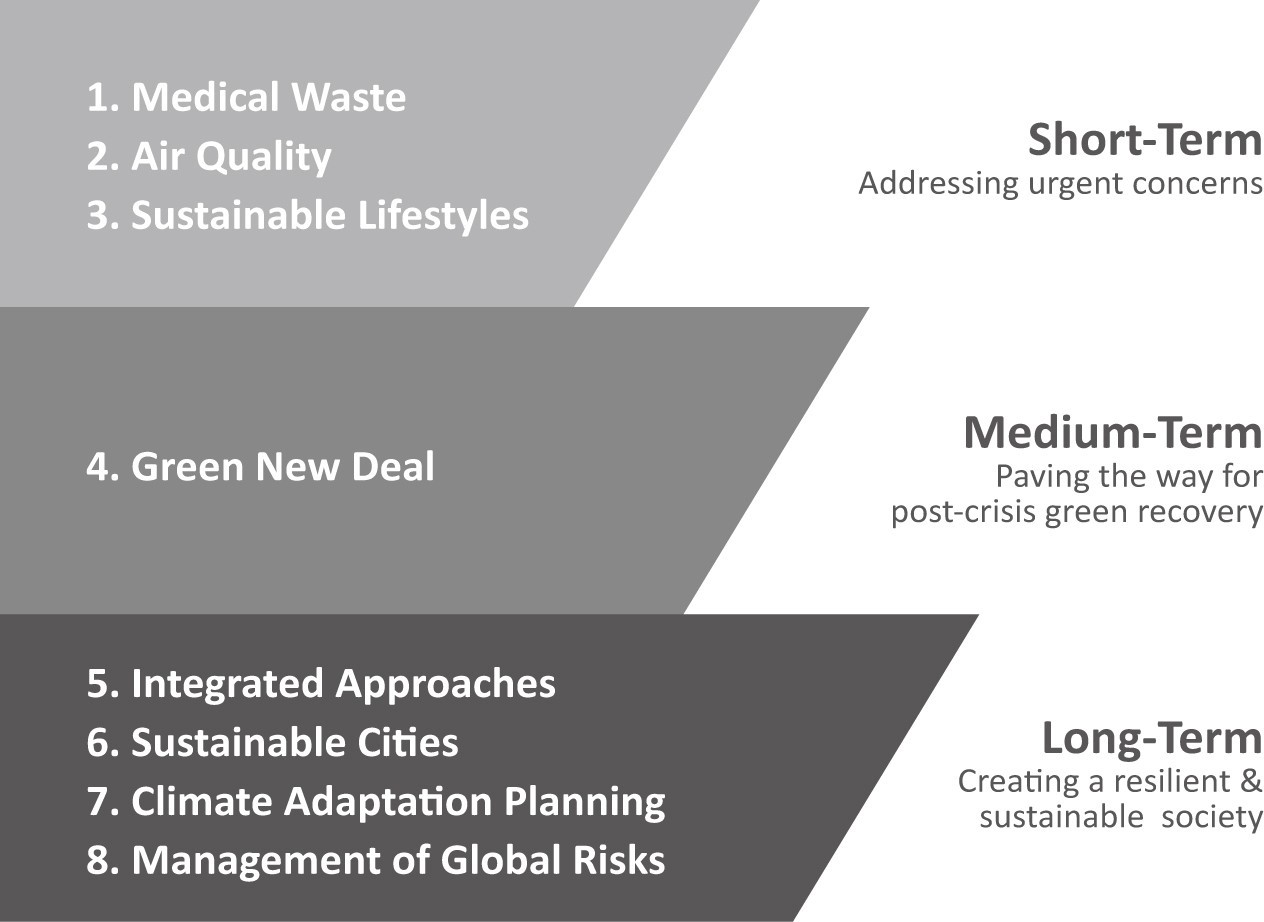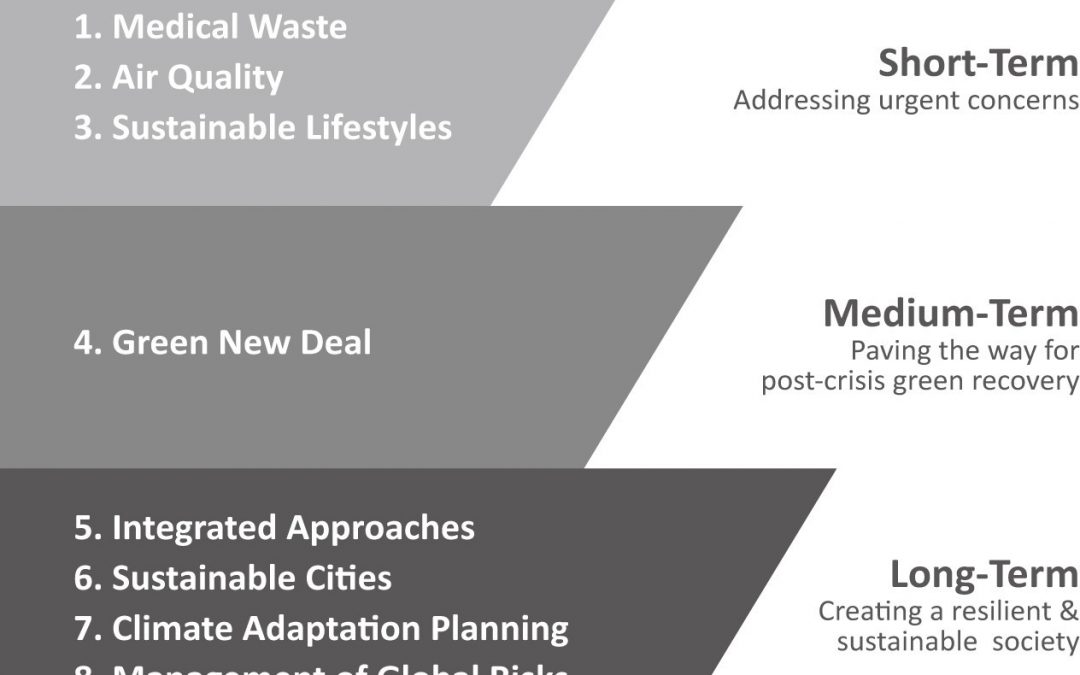Purpose of this Paper
In a few short months, COVID-19 has morphed from a dangerous regional health threat to an all- consuming global pandemic and economic disaster. COVID-19’s rapid spread has had far-reaching implications on the everyday lives of people in nearly all corners of the world, and underlines the need for governments at all levels to coordinate cross-cutting and cross-boundary response and recovery programmes.
Global And India’s sustainability is at the core of the IHCF mission. The Institute is thus dedicated to working across international boundaries ,specially our Indian’s concern and across issues to support response and recovery. In this position paper, we identify key issues through the lens of the environment and sustainability. We consider this view essential in dealing effectively with such pandemics and their wide-ranging impacts in the short-, medium- and long-term. In addition to presenting issues where we see scope for IHCF work over different time periods .
Fundamental Principles
The COVID-19 crisis was caused by a combination of two related phenomena. The first is the increasingly complex and potentially harmful interaction between humans and wildlife. The harvest and sale of wild animals and plants is a constant threat to the survival of many species, as well as occasionally posing a hazard to human society through viruses, as in the current case. Indeed, research suggests that increases in human exploitation of wildlife may lead to the further possibility of virus transmission from animals to humans. The second phenomenon is the ubiquitous and accelerated movement of people and goods across borders – a feature of modern globalisation.
It is equally essential to understand COVID-19’s far-reaching implications. As of 11 May 2020, over 4 million people officially tested positive for the virus and more than 270,000 had died as a result2 This tremendous loss of life demonstrates the sheer gravity of the crisis. COVID-19 tends to have a greater effect on the elderly, and those with underlying health conditions (although it has proved a threat to people of all ages, including those who are otherwise healthy). Poorer or marginalised segments of society are more likely to be disproportionately affected because of compromised health and inadequate social safety nets3. The pandemic may therefore increase socioeconomic inequality. It is already threatening to overwhelm health care systems and undermine political systems that find themselves ill-equipped to manage an emergency of this scale. These strains on social stability and government capacities are exacerbated by an economic crisis of greater magnitude than the 2008 financial crisis. Effective responses and recovery plans will therefore need to take into account the pandemic’s multiple dimensions as well as its deep roots in environmental stresses and global mobility.
An additional consideration is that pandemics like COVID-19 appear more likely to occur in the future, based on analyses of outbreaks in the last few decades4. The COVID-19 outbreak is the third documented coronavirus pandemic this century, following SARS and MERS in 2003 and 2012, respectively. Three outbreaks within 20 years is indeed an alarming trend, made even more striking when we consider that in the current era – known as the Anthropocene5 – climate change and biodiversity loss have already transgressed planetary boundaries (where human impacts have exceeded the capacity of the Earth). The world thus appears more vulnerable to destabilising crises of comparable or greater magnitude. It is within this context, and more broadly due to “human induced disturbance of host-parasite co-evolutionary relationships”6, that experts have warned that pandemics like COVID-19 will occur with potentially greater frequency and graver impacts that integrates economic recovery from COVID-19, climate action .The recovery process serves as a critical occasion to materialise much-needed transformative change toward a sustainable society. Some solutions will be needed in the immediate future while others will be important over the longer term. As such, IHCF has conducted this preliminary analysis to understand the environmental and sustainability challenges associated with the crisis, and their potential solutions, by categorising core issues requiring attention in the “short-term”, “medium-term”, and “long-term”.

Core short-term, medium-term, and long-term environment and sustainability challenges in the face of COVID-19 and the post-pandemic recovery.
Short-term Measures: Addressing Urgent Concerns
Governments around the world are currently taking measures such as declaring a state of emergency and social distancing to slow down the spread of COVID-19 and avoid overwhelming healthcare systems. First and foremost, containing the infection to protect human life and cope with the associated socioeconomic impacts is of the utmost priority. With this consideration, the following three points are also thought to be important from an environmental perspective.
Management of Medical Waste
Healthcare facilities have experienced an explosion in the use of specific kinds of medical supplies, including disposable masks and gloves, which has caused a rapid increase in medical waste.8 Managing this issue effectively is an urgent and pressing need, in part to avoid this waste from becoming another source of contamination from the virus. The World Health Organization (WHO) and the Basel Convention provide international guidelines on managing medical waste.
Many facilities, however, lack appropriate systems for medical waste management (e.g. small and medium-sized hospitals, hotels housing patients, quarantine facilities, nursing homes). In developing countries, waste management facilities may still be inadequate. In such cases, medical waste could be haphazardly mixed with household waste. Inappropriately discarded medical supplies may contaminate recyclable waste streams, posing health risks to waste management workers and adding difficulties to pre-existing waste segregation and treatment systems such as composting.
Managing the Adverse Impacts of Air Pollution
Air pollution is responsible for roughly seven million premature deaths annually.10 In locations with high levels of air pollution, the proportion of residents suffering from respiratory illnesses is high. Individuals infected with COVID-19 are thus likely to be at higher risk for serious illness and premature death.
Lombardy and Romagna regions of Italy12, where mortality and morbidity rates and air pollution were particularly high.
The air quality in India and numerous developing countries is among the worst in the world13, and high mortality and morbidity rates due to these interrelated risks may climb quickly in such regions. It is true that COVID-19 emergency lockdowns and stay-at-home restrictions have made ambient air quality in many Asian and other cities significantly better.14 Therefore, it is important to identify sustainable solutions that prevent pollution levels from rebounding or reaching higher levels after the crisis subsides.
Uptake of Sustainable Workstyles and Lifestyles
As a result, commuting time has decreased drastically. An associated decrease in greenhouse gas (GHG) emissions is also expected. Moreover, improvements in air quality and other secondary effects have been observed in both developed and developing countries. Such practices may improve not only the environment but also work-life balance, and should be maintained to the extent possible, even after the emergency period ends (albeit recognising that there may be some post-recovery rebounds). It is recommended that these lifestyle changes be promoted and become mainstreamed in society18 as part of a broader effort to transform behaviours needed for a net zero carbon society. Going forward, while reflecting on experiences during the COVID-19 pandemic, it is necessary to consider what kinds of policies would be needed in order to realise this transformative behavioural change.
Medium-term Measures:
Paving the Way for Post-Crisis Green Recovery
The implementation of various progressive policies suggests that the world will eventually shift from a state of emergency to a “new normal”. Since office and business closures have had a large impact on income and employment, it is a given that measures which directly address economic impact will be prioritised once the threat of infection declines sufficiently. For many, however, measures such as income compensation will be insufficient. It is important to take actions that build a society more adept at managing similar crises in the future, i.e. “build back better” after the crisis. Going forward, it will be important that each country’s large-scale economic measures contribute to building a more sustainable, resilient and inclusive society in the future (i.e. the implementation of a “global” Green New Deal).
- Promotion of Green Recovery
Currently, countries are trying to prepare for and introduce stimulus packages to recover from closure, or loss of business or employment. However, conventional economic stimulus measures (e.g. support for fossil fuel-intensive industries, expansion of the construction sector) may bring about short-term economic recovery, while failing to achieve the long-term changes in the socioeconomic structure necessary to prevent similar crises. Thus, economic stimulus directed at recovery from COVID-19 will also have to contribute to the transition toward resilient and decarbonised societies.
Moreover, measures must be taken to address ways in which trade and the movement of people and goods contributed to the global outbreak of COVID-19, and the enormous human and economic toll that has come with it. With an eye on the threats to global sustainability (such as future pandemics and climate change), current systems must be reevaluated to strengthen the resilience of countries, regions, and the entire globe.
A green recovery, which can serve as the starting point, is necessary. The EU announced its European Green Deal (EGD) in December last year. The EGD includes a goal to realise net zero GHG emissions by 2050 (in other words, become the world’s first ‘climate-neutral’ region), and outlines a vision for the EU’s environmental policies to achieve this goal20. The EU has retained the EGD, despite the economic crisis it is facing due to COVID-19, and has confirmed that it will continue to promote this programme. Meanwhile in Asia, the Government of the Republic of Korea announced its own version of the Green New Deal and is also aiming for carbon neutrality by 205021. -
Initial potential IGES actions
IGES is conducting a review of the role and progress of the European Green Deal, and recently presented at a press seminar22 in April 2020 to point out the importance of creating a Japanese version of the Green New Deal.Similar research is being conducted in numerous countries where such economic packages are being implemented. IGES plans to analyse the extent to which Japan’s emergency economic measures incorporate environmental measures (e.g. towards RE100). Moreover, through collaboration with various international partners, IGES is monitoring how each country’s economic recovery plan will incorporate the concept of green recovery, and is evaluating these policies. This work could also be linked to research on the SDGs; IGES has done work on the environmental dimensions of the global goals, demonstrating the potential to use the SDGs to evaluate funding decisions. Integrating the SDGs into the review and screening of COVID-19 recovery packages could make them more sustainable and help accelerate progress on the SDGs.
Long-Term Measures: Creating a Resilient and Sustainable Society
To reduce the likelihood of similar pandemics in the future, it is necessary to minimise root causes of infectious diseases and consider large-scale measures that strengthen resilience. The socio-economic system must undergo a far-reaching transformation. From an environmental perspective, it is important to recognise that phenomena such as climate change and the loss of ecosystems and biodiversity are thought to be underlying factors associated with the pandemic. Based on this, it is prudent to rapidly move forward with transformations toward the achievement of the Paris Agreement and the SDGs.
- Sustainable and Integrated Approaches
The COVID-19 outbreak is believed to have been caused by the transmission of the virus to humans (zoonosis) and the subsequent widespread, rapid, and uncontrolled movement of infected people due to modern mobility. It is critical that these root causes are addressed. At the same time, in order to address the underlying factors of this pandemic, it is essential to significantly reduce uncontrolled land development and resulting ecosystem destruction, and rigorously implement climate change countermeasures to reduce the clear impacts of climate change on ecosystems.Moreover, it is important to build resilient localities that can work cooperatively with one another in times of emergency, so that risks can be managed more effectively. Frameworks such as the basis for increasing resilience and sustainability. The promotion of regional circulating and ecological spheres (Regional-CES)23, which aim for holistic sustainable development at the regional level through integrated efforts toward achieving diverse, social, economic and environmental targets, is also seen as a reasonable way forward in the long term.
Initial potential IGES actions
When considering using the Regional-CES concept to address sustainability challenges in Asia, it is necessary to consider measures to minimise infectious disease risk and strengthen measures to manage outbreaks if they do occur. IGES is planning to launch a case study on the application of the Regional-CES concept in two regions in Asia together with a number of partner institutes. One proposed research project on Regional-CES and pandemic response may focus on understanding urban-rural interdependency patterns in the event of pandemics, focusing on resource flows, economic recovery and collective resilience. -
Sound Urban Environmental Measures in Developing Countries
The majority of infected persons are city dwellers, since the virus is more likely to spread in densely populated locations. The urban dimension and root causes of pandemics are multiple and may be considered from several angles.First, in physical terms, essential daily activities, such as commuting and shopping, are carried out in relatively congested spaces. Sometimes the urban poor cannot avoid living in unsanitary and crowded informal settlements.
Second, cities are the engines of economic growth, enabling better quality of life and job creation. Economic growth is nevertheless associated with unsustainable production and consumption patterns. To shelter, feed, clothe and transport huge populations, cities confront all sorts of environmental challenges. Wildlife trade (of live species and their products) in cities is one such challenge, which brings with it the danger of new zoonotic infections.
Third, cities are primary sources of environmental pollution, which worsens the pre-existing health conditions of their inhabitants. As noted previously, studies have suggested a high correlation between increased deaths in urban regions with the most polluted air.
Finally, municipal waste streams in cities will experience a surge in the volume of disposables such as surgical masks and gloves. There is a real risk of derailed progress in the reduction of single-use plastics, which had gained traction before the COVID-19 outbreak. Use of single-use plastic bags, containers and utensils – which are perceived as more sanitary – may also increase significantly25. Furthermore, normal waste management systems could be disrupted due to safety concerns and lockdowns26. This means recyclables may not be collected and the potential of building a circular economy will be lost. In developing countries, this compounds existing solid waste management challenges where waste is not properly collected, treated and disposed of. Waste will end up in drainage systems and water bodies, thereby increasing the severity of water pollution and flash floods.
Measures to address these challenges should be fully integrated to address root causes and underlying factors. The currently dominant silo-based approach is considered woefully inadequate.
- Measures for Climate Adaptation Planning
It has been predicted that multiple causes, including climate change, land-use change and biodiversity loss, will lead to changes in the patterns of vector-borne diseases. To date, discussions on this issue have focused mainly on the increased habitat range for vectors such as mosquitoes (which carry diseases such as malaria and dengue fever). In the case of COVID-19, however, the outbreak was not caused by the increase in vector habitat range; rather, the virus spread across the globe through the rapid and massive movement of people associated with modern mobility. Indeed, local events resulting from unsustainable practices can be amplified by global mobility of goods and people.
Since this phenomenon is not seen to be directly related to climate change, such risks have not necessarily been sufficiently discussed within the context of climate adaptation. However, ecosystems are changing dramatically due to climate change.27 These changes expand transition zones where species from different habitats interact and thereby elevate the risk of pathogen spillover.28 In other words, it is fully conceivable that climate change can become an indirect factor contributing to the rise in frequency of infectious diseases like COVID-19. Therefore, as illustrated by this current crisis, it is necessary to consider infectious disease risk as another important impact of climate change. - Measures to Control Global Risks
COVID-19 has once again proven that global systems such as extended supply chains and tourism are vulnerable to global risks. In fact, the increasing globalisation of risk is in part due to climate change and biodiversity loss, as well as other sustainability issues. Some examples include the Bangkok floods in 2011, and the global food price crisis in 2008. This time, the COVID-19 crisis has disrupted critical supply chains for the automobile industry. Meanwhile, in the textile industry, low-income workers have been put at risk to maintain the global supply chain: it has been reported that 200,000 garment workers in Bangladesh had little choice but to return to work in factories despite the national lockdown.
The tourism industry has now been shown to be exposed to global risks. On one hand, COVID- 19 has nearly decimated the global tourism industry. On the other, excessive global tourism (i.e. over-tourism) has created serious local problems, including congestion, littering, as well as local culture disruptions in many tourist spots around the world. Now, it has unwittingly helped the spread of the virus, which is considered another associated risk. Indeed, it is necessary to seriously consider vulnerabilities associated with such global systems, by fully taking into account an appropriate balance between associated benefits and risks. To address the above, global-level measures are considered necessary. Given that vulnerable populations in developing countries will be disproportionately affected, measures to address this issue must be further strengthened.
Conclusion
With the aim of contributing to the creation of a resilient and sustainable world and to help minimise pandemic risks in the future, IGES has already started and will continue to lead research on the implications of COVID-19 and recommendations for effective multilateral and multilayered response and recovery in the short-, medium- and long-term. Working with domestic and international partners, IGES will continue to drive forward transformative change towards healthy people and a healthy planet.

